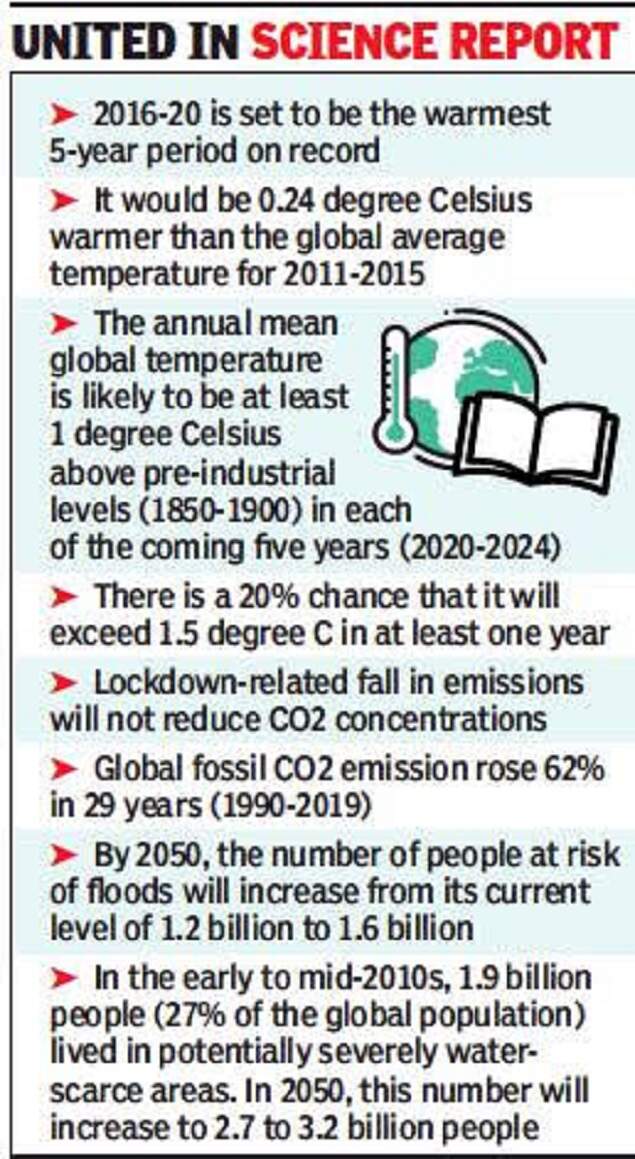
NEW DELHI: Emission of carbon dioxide in 2020 will fall by an estimated 4-7% compared to last year due to Covid-19 confinement policies which though seem to have had little effect on stemming climate change, says United in Science 2020 report of multiple global agencies, led by the World Meteorological Organisation (WMO).
The report, released on Wednesday, says reduction in emissions of the CO2 in 2020 will only slightly impact the rate of increase in atmospheric concentrations, which are the result of past and current emissions, as well as the very long lifetime of carbon dioxide.
Besides analysing global emission during the pandemic, the report also underlines how the Covid-19 situation has significantly impacted “global observing systems” which, in turn, have affected the quality of forecast and other weather, climate and ocean-related services.

Noting that the daily global fossil CO2 emissions dropped by an unprecedented 17% compared to 2019 during peak lockdown in early April, it says, “Even so, emissions were still equivalent to 2006 levels, highlighting both the steep growth over the past 15 years and the continued dependence on fossil sources for energy.
Though the exact decline will depend on the continued trajectory of the pandemic and governments’ responses to address it, the report highlights that the global daily fossil CO2 emissions had mostly returned to within 5% (1–8% range) below 2019 levels by early June, coinciding with the unlock phase in many countries.
The emission had reached a new record of 36.7 gigatonnes (Gt) last year which is 62% higher than 1990 - the year which saw the beginning of climate change negotiations.
“This has been an unprecedented year for people and the planet. The Covid-19 pandemic has disrupted lives worldwide. At the same time, the heating of our planet and climate disruption has continued apace,” said UN Secretary-General António Guterres in a foreword.
The report, released simultaneously in New York and Geneva, says emissions are heading in the direction of pre-pandemic levels following a temporary decline caused by the lockdown and economic slowdown, and the world is set to “see its warmest five years on record” during 2016-20 – a trend which is not on track to meet agreed targets to keep average global temperature increase well below 2 degree C or at 1.5 degree C by the end of the century above pre-industrial levels (1850-1900).
“Never before has it been so clear that we need long-term, inclusive, clean transitions to tackle the climate crisis and achieve sustainable development. We must turn the recovery from the pandemic into a real opportunity to build a better future,” said Guterres. He also called on governments to prepare new and ambitious national climate plans, the Nationally Determined Contributions, in advance of the next UN climate conference (COP26).
On the impact of pandemic on “global observing systems”, the report says the “reduction of aircraft-based observations by an average of 75% to 80% in March and April degraded the forecast skills of weather models”.
The impact was, however, more on manually operated weather stations compared to automated systems which continued to deliver data. In March, the report says nearly all “oceanographic research vessels” were recalled to home ports and commercial ships have been unable to contribute vital ocean and weather observations.
Though the impacts on climate change monitoring are long-term, the overall disruption during the pandemic will introduce gaps in the historical time series of essential climate variables needed to monitor climate variability and change and associated impacts.
Responding to a question of the UN Correspondents Association whether
it must have been pretty frustrating at times as countries like the United States and China have not exactly been very aggressive in cutting back their emissions and how it can be tackled by him in future, the UN Secretary-General said, “Well, first of all, it's important to notice that we have already 120 countries that have accepted carbon neutrality in 2050 and are establishing the plans to implement it. And that represents 25% of the emissions.
“So, the big question, as you mention, are the big emitters, and the big emitters are the United States, China, the European Union, Japan, Russia, India. I've been very actively engaged, both with the governments and the civil societies. I made recently conferences to a Chinese university, to an Indian university, aiming at convincing the big emitters, all of them, that it is absolutely crucial for them to commit to carbon neutrality in 2050 and to commit to a reduction of the emissions up to 2030 of 45%. Without the big emitters, all the efforts that are made will not be enough.”
Guterres in his response at the launch of the report noted that there has been a very important movement in the private sector - asset managers, banks, important multinational corporations -- and the civil society -- in cities, in states - towards strong commitment to reach carbon neutrality.
“So, all these reasons make me believe that the pressure of the governments of big emitters will sooner or later produce results. It will be possible to have a global commitment and the nationally determined contributions change that will be presented up to the COP26 in Glasgow are the real opportunity to do so. I still hope that the global emitters will also commit to carbon neutrality in 2050,” he said.
The report, released on Wednesday, says reduction in emissions of the CO2 in 2020 will only slightly impact the rate of increase in atmospheric concentrations, which are the result of past and current emissions, as well as the very long lifetime of carbon dioxide.
Besides analysing global emission during the pandemic, the report also underlines how the Covid-19 situation has significantly impacted “global observing systems” which, in turn, have affected the quality of forecast and other weather, climate and ocean-related services.

Noting that the daily global fossil CO2 emissions dropped by an unprecedented 17% compared to 2019 during peak lockdown in early April, it says, “Even so, emissions were still equivalent to 2006 levels, highlighting both the steep growth over the past 15 years and the continued dependence on fossil sources for energy.
Though the exact decline will depend on the continued trajectory of the pandemic and governments’ responses to address it, the report highlights that the global daily fossil CO2 emissions had mostly returned to within 5% (1–8% range) below 2019 levels by early June, coinciding with the unlock phase in many countries.
The emission had reached a new record of 36.7 gigatonnes (Gt) last year which is 62% higher than 1990 - the year which saw the beginning of climate change negotiations.
“This has been an unprecedented year for people and the planet. The Covid-19 pandemic has disrupted lives worldwide. At the same time, the heating of our planet and climate disruption has continued apace,” said UN Secretary-General António Guterres in a foreword.
The report, released simultaneously in New York and Geneva, says emissions are heading in the direction of pre-pandemic levels following a temporary decline caused by the lockdown and economic slowdown, and the world is set to “see its warmest five years on record” during 2016-20 – a trend which is not on track to meet agreed targets to keep average global temperature increase well below 2 degree C or at 1.5 degree C by the end of the century above pre-industrial levels (1850-1900).
“Never before has it been so clear that we need long-term, inclusive, clean transitions to tackle the climate crisis and achieve sustainable development. We must turn the recovery from the pandemic into a real opportunity to build a better future,” said Guterres. He also called on governments to prepare new and ambitious national climate plans, the Nationally Determined Contributions, in advance of the next UN climate conference (COP26).
On the impact of pandemic on “global observing systems”, the report says the “reduction of aircraft-based observations by an average of 75% to 80% in March and April degraded the forecast skills of weather models”.
The impact was, however, more on manually operated weather stations compared to automated systems which continued to deliver data. In March, the report says nearly all “oceanographic research vessels” were recalled to home ports and commercial ships have been unable to contribute vital ocean and weather observations.
Though the impacts on climate change monitoring are long-term, the overall disruption during the pandemic will introduce gaps in the historical time series of essential climate variables needed to monitor climate variability and change and associated impacts.
Responding to a question of the UN Correspondents Association whether
it must have been pretty frustrating at times as countries like the United States and China have not exactly been very aggressive in cutting back their emissions and how it can be tackled by him in future, the UN Secretary-General said, “Well, first of all, it's important to notice that we have already 120 countries that have accepted carbon neutrality in 2050 and are establishing the plans to implement it. And that represents 25% of the emissions.
“So, the big question, as you mention, are the big emitters, and the big emitters are the United States, China, the European Union, Japan, Russia, India. I've been very actively engaged, both with the governments and the civil societies. I made recently conferences to a Chinese university, to an Indian university, aiming at convincing the big emitters, all of them, that it is absolutely crucial for them to commit to carbon neutrality in 2050 and to commit to a reduction of the emissions up to 2030 of 45%. Without the big emitters, all the efforts that are made will not be enough.”
Guterres in his response at the launch of the report noted that there has been a very important movement in the private sector - asset managers, banks, important multinational corporations -- and the civil society -- in cities, in states - towards strong commitment to reach carbon neutrality.
“So, all these reasons make me believe that the pressure of the governments of big emitters will sooner or later produce results. It will be possible to have a global commitment and the nationally determined contributions change that will be presented up to the COP26 in Glasgow are the real opportunity to do so. I still hope that the global emitters will also commit to carbon neutrality in 2050,” he said.
Download
The Times of India News App for Latest India News

Coronavirus outbreak
Trending Topics
LATEST VIDEOS
India
 LAC row: India will retaliate in case China breaches red lines, says top govt official
LAC row: India will retaliate in case China breaches red lines, says top govt official  Didn't receive any letter: Hemant Soren after NGT slaps fine on Jharkhand HC, legislative assembly buildings
Didn't receive any letter: Hemant Soren after NGT slaps fine on Jharkhand HC, legislative assembly buildings  RJD, SP and Congress protest over unemployment by lighting lamps, candles
RJD, SP and Congress protest over unemployment by lighting lamps, candles  J&K: 2 CRPF personnel injured in grenade attack in Anantnag
J&K: 2 CRPF personnel injured in grenade attack in Anantnag  Uttarakhand presents Badrinath beautification master plan to PM Narendra Modi
Uttarakhand presents Badrinath beautification master plan to PM Narendra Modi  UK Court discusses prison conditions on day 3 of Nirav Modi's extradition trial
UK Court discusses prison conditions on day 3 of Nirav Modi's extradition trial
More from TOI
Navbharat Times
Featured Today in Travel
Quick Links
Coronavirus in MumbaiCoronavirus in KolkataCoronavirus in HyderabadCoronavirus in DelhiCoronavirus in BangaloreCoronavirus symptomsCoronavirus in IndiaWhat is CoronavirusCoronavirus NewsSolar EclipseNPRWhat is NRCCAB BillCAB and NRCRTI BillPodcast newsLok SabhaShiv SenaYSRCPCongressBJP newsUIDAIIndian ArmyISRO newsSupreme Court
Get the app



